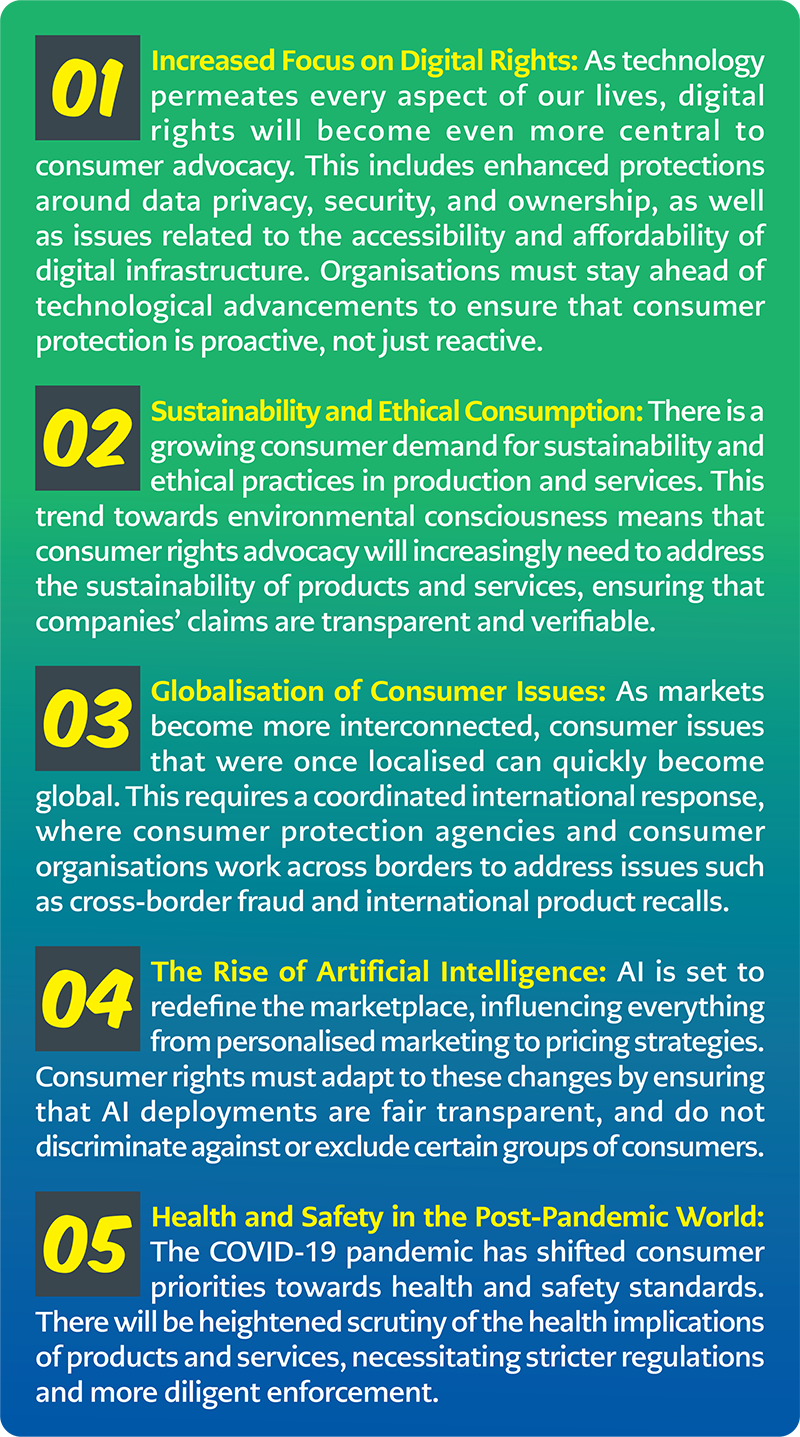Navigating Consumer Rights Amidst Technological Shifts
In an insightful conversation with the Fourth Leap Team, Datuk Marimuthu Nadason, President of Consumers International and a stalwart in global advocacy, delves into the evolving landscape of consumer rights in the digital era. with decades of experience, Marimuthu discusses the challenges and opportunities presented by emerging technologies and their implications.

As president of Consumers International, how do you see digital rights evolving in the context of the Fourth Industrial Revolution? What are the key challenges and opportunities?
Addressing the complexities of digital rights during the Fourth Industrial Revolution proves both challenging and invigorating in my capacity at Consumers International. Our primary challenge is safeguarding privacy in an era dominated by Artificial Intelligence (AI) and Internet of Things (IoT) technologies. Implementing robust data protection laws globally is imperative, as the risks of breaches escalate with more interconnected devices.
Another pressing issue is the digital divide. Whilst technology promises enhanced accessibility, it also risks widening the gap between those with and without access. Addressing this disparity is essential to ensure equitable benefits from digital advancements.
On the opportunities front, the digital age offers remarkable tools for consumer empowerment. Access to comprehensive product information and peer reviews can significantly bolster consumers’ decision-making. Moreover, technologies like blockchain hold the potential to revolutionise consumer protection by providing transparency and security in transactions.
Furthermore, the global nature of the digital world permits unprecedented collaboration across borders. This presents an opportunity to harmonise consumer protection standards internationally, ensuring a more unified approach to safeguarding consumer rights.
We need to leverage these opportunities while tackling the challenges, advocating for policies that protect and empower consumers globally, and ensuring that the benefits of technological advancements are widely and fairly distributed.

Addressing digital rights is vital in the rise of the Fourth Industrial Revolution, further reducing the risk of escalating breaches with more interconnected devices.
Could you discuss specific examples of how emerging technologies have posed new risks or offered new tools for consumer protection?
Emerging technologies have a dual impact on consumer protection. They introduce new challenges and exciting tools that we need to address actively.
On the risk side, technologies like IoT devices are a prime example. These devices collect massive amounts of data, posing significant privacy risks. For instance, smart home devices or even cars can monitor almost every aspect of one’s daily life, raising serious questions about privacy and data security. We must advocate for robust privacy regulations in these cases.
Another risk involves the complexity of AI systems. These systems often operate in non-transparent ways, leading to biases in decisions that affect everything from credit approvals to hiring. We must advocate for standards that ensure these technologies operate transparently and fairly.
As for the opportunities, blockchain technology is a game changer for enhancing transparency. It offers a way to securely trace product journeys from manufacture to sale, which can be particularly valuable in industries like pharmaceuticals, where verifying authenticity is critical.
AI is also revolutionising consumer protection, especially fraud detection. Financial institutions use AI to analyse transaction patterns and identify real-time fraud, significantly enhancing consumer security.
Lastly, Regulatory Technology, or RegTech, helps companies meet compliance demands more efficiently. This not only aids businesses but also enhances the protective measures in place for consumers by ensuring regulations are followed more rigorously.

With your extensive experience on the international stage, how do you approach harmonising consumer rights across different regulatory environments, especially with the varying impacts of digitalisation?
Harmonising consumer rights across diverse regulatory environments is a complex challenge, particularly in the digital age, where technological change varies widely between regions.
Firstly, collaboration is essential. We engage closely with consumer organisations, industry players, governments, and international bodies worldwide. This collaborative approach allows us to understand different regions’ specific needs and challenges and advocate for policies that can be adapted and adopted globally.
Secondly, we strongly emphasise the importance of international standards. For example, in digital privacy and data protection, we advocate for standards that reflect the highest level of consumer protection, drawing inspiration from stringent frameworks like the EU’s GDPR (General Data Protection Regulation). These standards serve as a guide that less regulated markets can aspire to and more regulated markets can endorse.
Thirdly, education and capacity building are crucial. We help our global membership of consumer organisations in various countries to understand international best practices and the importance of consumer rights in the digital world. By raising awareness and building capacity, we empower local advocates to push for incorporating the consumer voice viz-a-viz stronger regulations in their respective environments.
Finally, we focus on the impact of digitalisation itself. Given its transformative power, we advocate for digital access to be recognised as a fundamental consumer right. This is crucial for ensuring that the benefits of digitalisation, such as access to information and markets, are universally accessible, which in turn supports a more harmonised approach to consumer rights globally.

Blockchain technology is a game changer for enhancing transparency.
What have been the most significant changes in consumer advocacy under your leadership, particularly in response to the digital economy and global crises like the pandemic?
Our response to the digital economy has focused more on digital rights. We have advocated for improved data privacy and security protections, acknowledging the growing concern over how corporations manage and utilise consumer data. We have also pushed for more transparent algorithms to ensure fairness in automated decisions that affect consumers, from credit scoring to job applications.
In addition, during the pandemic, our approach quickly adapted to address emerging consumer issues. As more people moved online for education, work, and health services, we emphasised the importance of access to reliable and affordable internet services. Consumer rights in e-commerce also took precedence as online shopping became more prevalent, raising issues around consumer fraud, consumer redress such as refunds, returns, and replacements, and the right to clear information.
Lastly, we have worked to strengthen global cooperation among multiple stakeholders. The pandemic highlighted the need for international collaboration to tackle cross-border consumer issues, such as scams and price gouging. We have built more robust networks with consumer organisations in various regions and worldwide to share information and strategies more effectively, ensuring that consumer protection remains strong even as global challenges evolve.

The global nature of the digital world permits unprecedented collaboration across borders, which allows us to engage closely with consumer organisations, industry players, governments, and international bodies worldwide.
What significant trends do you foresee in consumer rights, and how should organisations prepare to meet these changes?
There are several key trends that I foresee in consumer rights that will shape our approach and strategies:

Countries should prepare for these changes by investing in research and technology to better understand and advocate for these evolving consumer needs. Strengthening global partnerships and fostering a culture of innovation within consumer advocacy will be crucial for effectively responding to these trends.





